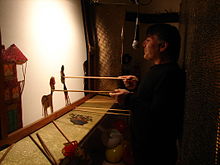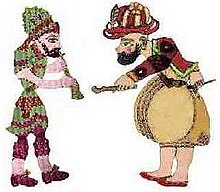Karagöz Theater
Karagöz ( Turkish ) "black eye" is the name for the Turkish shadow play , in which a tasvir, called a human, animal or object, made of a camel or cow skin, is moved back and forth behind a white curtain in strong backlight.
Comparable humorous stories of the shadow theater, named after its main character Karagöz , include the German puppet theater performed with puppets .
characters
Karagöz is a cheerful, simple, but witty-clever man from the people. He is a rude, sensual figure who, for lack of money, often has to take on tasks that she is not up to (e.g. writing letters for others).
Hacivat is an educated representative of the urban educated class and the politely educated neighbor of the Karagöz. In the Great Turkish Dictionary of the Türk Dil Kurumu (Institute for the Turkish Language) it is described as follows:
“Hacivat gets along with everyone and thus pursues their interests, he is moderate and can slip into all roles. He is someone who, when it is beneficial to his own interests, turns a blind eye. Since he has a little schooling, he knows at least something about everything and is therefore a semi-intellectual. He adheres to the social code of conduct, but not out of conviction. Hacivat does any job for money, from muhtar (village chief) to marriage broker (çöpçatan) . He knows something about trading and doesn't make any effort to make money. He lets Karagöz do hard work for a small wage. Hacivat mostly embodies the role of the employer and is therefore the representative of the social order. He is an opportunist in character. Hacivat loves to express himself swollen and in high Ottoman language. This type of conversation is in his best interest when things get more complicated and he introduces some incomprehensible Ottoman terms into the conversation, thus saving his neck from the noose. "
In addition to these two characters, other characters appear in the Karagöz Theater. These are representatives of Istanbul society and the various religious and ethnic groups of the Ottoman Empire , but also fringe groups and mythical creatures . The more contrasting the characters represented by the individual figures, the more possibilities there are for comedy , irony and satire in the shadow play . Sometimes also as a socially critical theater genre, shadow play is a mirror of late Ottoman society. The multicultural context is the main theme at the level of linguistic communication.
Further figures are in detail:
- female characters: Zenneler, Kanlı Nigar, Salkım İnci, wife of Karagöz, daughter of Hacivat; Canan (the mistress)
- Speakers of the Istanbul dialect: Çelebi and Tiryaki ...
- Anatolians: Laz (the Lase ), Bolulu (from Bolu ), Kayserili (from Kayseri ), Kürt ( Kurd ) and Kastamonulu (from Kastamonu ).
- Characters outside of Anatolia: Arnavut ( Albanians ), Arap ( Arabs ) and Acem ( Iranians ) ...
- Non-Muslims: Rum ( Greek ), Ermeni ( Armenians ) and Yahudi ( Jew ) ...
- Guilty and mentally ill: Kekeme (stutterer), Kambur (hunchback), Tuzsuz Deli Bekir (madman) ...
- Gangsters and drunks: Matiz, Casuslar (spies and snoops), Sarhoş (drunk) ...
- Actors and artists: Köçek (effeminate dance boy), Çengi (player of the çeng harp ), Cambaz (tightrope walker) and Hokkabaz (magician) ...
- Spirit beings : Cinler
- Side effects: Satıcılar (seller) ...
Origin and Distribution
Karagöz is related to other Asian shadow play traditions including Chinese shadow theater . With the Wayang Kulit in Indonesia, the Nang Yai in Thailand, the Tolubommalata in South India and other puppet shows, the Karagöz shares plot-based sexual suggestions and political humor, combined with criticism of the rulers, characteristic of forms of entertainment for the lower and rural sections of the population is.
There are different opinions about the introduction to Turkey: One of them is that the puppet plays kor kolçak and çadır hayal were shadow plays in Central Asia and from there they got to Anatolia . According to another view, the shadow play came to Turkey together with the shadow players that Sultan Selim I brought with him after the conquest of Egypt in 1517. It is possible that the Central Asian Turkic peoples have known shadow games since the 12th century, but they have only been detectable in Turkey since the 16th century. The Arab shadow play of the Egyptian Mamluks consisted of large shadow figures that had little in common with those of the Karagöz.
Compared to other forms of theater, especially playing with three-dimensional puppets, the Karagöz had an advantage in that it only depicts human beings very indirectly and thus violates the Islamic ban on images to a lesser extent . According to the Austrian Ottoman artist Andreas Tietze, the rise of shadow theater does not happen by chance at a time when the power of the ulema and its influence on public life was increasing.
During the Ottoman Empire, the Karagöz theater also came to Greece , where it is still popular today under the name Karagiozis (Καραγκιόζης). The main character Karagiozis of the Greek folk theater embodies the simple, poor, peasant cunning Greek who bravely asserts himself against the Ottoman (perceived as foreign rule) authorities. The decision by UNESCO in September 2009 to include the Karagöz Theater in the Representative List of the Intangible Cultural Heritage of Humanity at the Turkish suggestion sparked cautious protests in Greece.
When the Ottomans ruled the Arab countries of North Africa, Karagöz was introduced there too. In Tunisia, among other nationalities, black Africans were among the doll figures. The metal rattles chkachek ( shaqshaq ) served as sound instruments .
Traditions and technical implementation
Traditionally, the shadow play was performed during the fasting month of Ramadan and at circumcision festivals. The performances took place in coffee houses , in private apartments of wealthy citizens, but also at the Sultan's court . Karagöz players ( karagözcü , hayyâlbâz ) used to present a different piece to the audience for each day in Ramadan and thus played 30 different pieces, some of which were improvised. No written text templates existed until the 19th century.
A Karagöz piece traditionally consists of a mystical ghazel ( perde gazeli ), a dialogue ( muhavere ), the main story ( fasıl ) and an epilogue . The pieces are not related to each other. The stage is bordered on both sides by the houses of the protagonists Karagöz and Hacivat. The play figures are made of colored, translucent cowhide or camel leather , are posable and usually 20–40 centimeters high. They are pressed against a fabric lit with oil lamps or candles and moved with one or the main character with two sticks.
All shadow puppets are led by a single Karagöz player. He speaks the voices of the various characters, also sings songs and provides accompanying noises. A complete shadow play group also includes two musicians who play frame drums with bells ( daire ) and flute . The accompanying music in the Karagöz theater cannot be clearly assigned to classical Ottoman art and folk music. The different accents are introduced with songs that are typical of certain regions.
See also
literature
- Hans Leo Bobber u. a .: Turkish shadow theater Karagöz. A handout for enjoyable learning. Dolls & masks, Frankfurt a. M. 1983
- Erika Glassen : The Turkish shadow theater: a mirror of late Ottoman society. In: Johann Christoph Bürgel (ed.): Social upheaval and history in contemporary drama in the Islamic world. Steiner, Stuttgart 1995, ISBN 3-515-06705-1 , pp. 121-137 ( online ).
- Hellmut Ritter (Ed.): Karagös. Turkish shadow games. Istanbul 1941
- Otto Spies : The game of the wrong slave trader. A Turkish shadow play. In: Oriens, Vol. 17, Brill, December 1964, pp. 1-59
- Karl Süssheim: The modern figure of the Turkish shadow play (Quaragöz). In: Journal of the German Oriental Society , Vol. 63, Harrassowitz, Wiesbaden 1909, pp. 739–773
Web links
- Information, video and images about the Karagöz Theater on the UNESCO website
- Welcome to the website of the traditional shadow play Karagöz karagoz.net
Individual evidence
- ↑ Büyük Türkçe Sözlük: Hacivat , accessed on February 12, 2009
- ^ Serdar Öztürk: Karagöz Co-Opted: Turkish Shadow Theater of the Early Republic (1923–1945). In: Asian Theater Journal , Vol. 23, No. 2, autumn 2006, pp. 292-313, here p. 292
- ^ Fan Pen Chen: Shadow Theaters of the World. In: Asian Folklore Studies, Vol. 62, No. 1, 2003, pp. 25-64, here p. 30
- ↑ http://www.unesco.org/culture/ich/index.php?lg=en&pg=00011&RL=00180
- ↑ Kathimerini of July 15, 2010: "Greece to press Karagiozis claims"
- ↑ Lois Ann Anderson: The Interrelation of African an Arab Musics .: Some Preliminary Remarks. In: Klaus P. Wachsmann (Ed.): Essays on Music and History in Africa. Northwestern University Press, Evanstone 1971, p. 160


